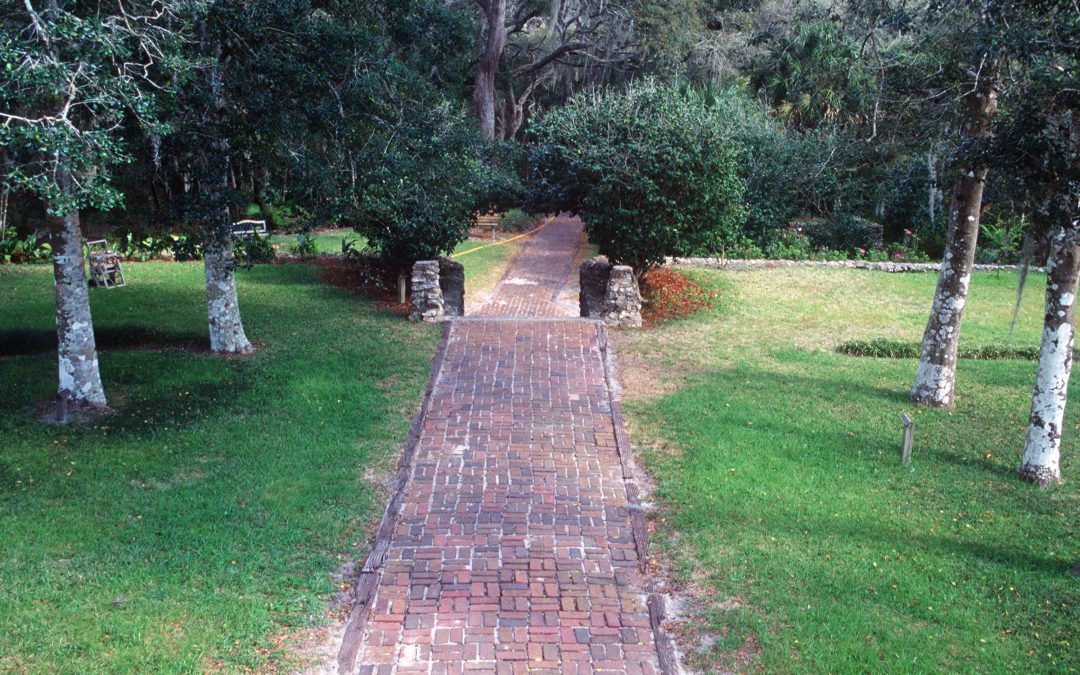
by Joshua Criss | Jun 2, 2022
The lawn is a staple when you picture the typical American home. It is where your kids play, where you stand to associate with your neighbors and the first impression you give to passers-by. It has also no doubt been a subject of frustration as you notice brown patches or open spots. Could this situation have been avoided in the first place? Lawn care is a topic we address in extension extensively. Proper maintenance practices will help your lawn be green and healthy providing you with years of enjoyment. Below are a few principles that if applied will help you avoid issues and grow a worry-free yard.
First Steps
Before you do anything else you will need to know what species you are working with. In this area we have warm season grasses with names like centipede and zoysia. Their individual characteristics will identify yours from the others. For instance, centipede grass is a lighter color with a course textured blade about 1/16 to 1/8 inches wide and a creeping habit as it spreads via stolon. This is very basic, as identifying grasses could be a day long course on its own. Knowing your lawn species will inform you as to mowing height and when periodic tasks such as dethatching may be necessary. All of these are necessities for a healthy lawn, but there are two universal tasks that need to be on the forefront of your mind.
Irrigation
Irrigation is arguably the most important topic in lawn care. Improper watering may cause your grass to die back opening bare spots for weeds and insects to infiltrate. Scheduled irrigation is not the best option. Your grass will tell you when it needs water. Look for indicators such as folding blades, color change, and lingering footprints as keys to irrigation. When you see these, apply ½ to ¾ inch of water preferably in the early morning. Take your soil type into consideration when watering as you will want this water in the root zone. Sandy soils may need a little more to saturate the area while clay may need to soak in through multiple applications. Watering only when required will encourage deeper rooting of your grass. So, how do you know how long to run your system? Calibrate your system by placing straight sided cans in your watering zones. Run the system until they fill to the desired level. The amount of time this takes will tell you how long you should run the system. While you are calibrating the system, take a look at where the sprinkler heads are aimed. Readjust any that place water in undesired locations like the street. Lastly, install a rain sensor. The Panhandle received an average 68.32 inches of rain in 2021*. There is no need to run your water system if mother nature is doing it for you.
*per FL Climate Survey https://climatecenter.fsu.edu/images/docs/Fla_Annual_climate_summary_2021.pdf
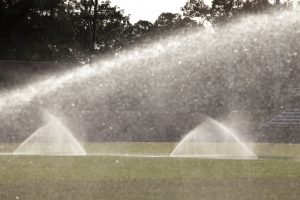
UF/IFAS Photo by Tyler Jones.
Fertilizing
Fertilization is another often misunderstood topic. Grass is a plant, and therefore requires nutrients to thrive. Over doing it in certain grasses may cause them to die back much like improper irrigation. Application rates vary by grass species and are given in terms of required nitrogen per 1000ft2 for a single growing season. You can tell how much Nitrogen a fertilizer has by looking at the first of the three-digit NPK rating. It indicates the amount by weight in the bag (8-8-8 = 0.08lbs nitrogen per 1lb fertilizer). Keep in mind that rate of fertilizer your grass needs is for the entire year. This means you will want to apply multiple times. So, if you need 13lbs of fertilizer it is best to apply about 4.33lbs three times across the growing season versus all at once. Only apply fertilizer during active growth. In the Panhandle this is mid-April through mid-September. Appropriate rates and timing will keep those expensive fertilizers in your root zone and not in our local waterways.
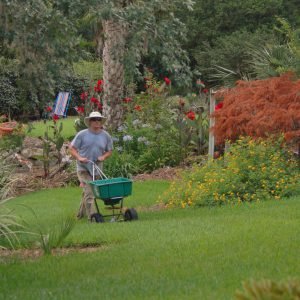
UF/IFAS Photo
Appropriate care will provide lush healthy growth and a full lawn. Taking the time to identify your grasses will inform you as to what it needs to support your family for years to come. Appropriate irrigation and fertilization will in-turn support the health of local watersheds and potentially save you some money and effort. For more information on lawn maintenance, see these Ask IFAS documents, or contact your local extension agent for additional information on this and any topic regarding your gardens and more.
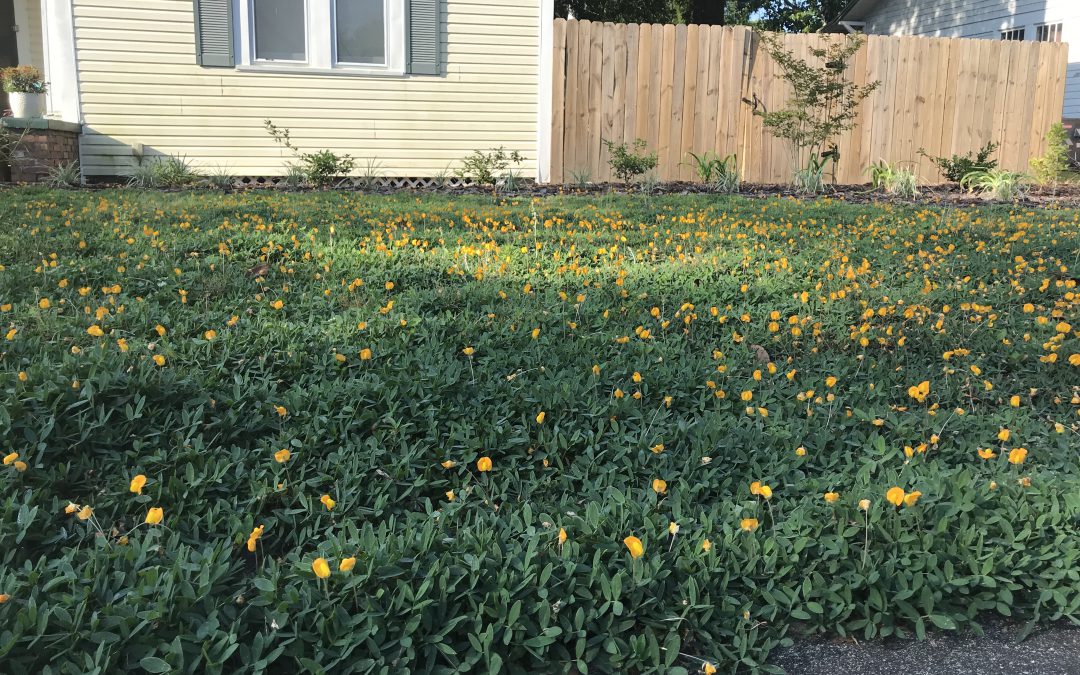
by Matt Lollar | May 5, 2022
Turf lawns provide an excellent groundcover that hold soil in place, filter pollutants, and are beautiful. However, turfgrass may not be your first groundcover choice, due to heavy shade, landscape layout, or just personal preference. In that case, there are a lot of alternative groundcovers on the market. To help determine what groundcovers do best under certain conditions and to provide information on lawncare and groundcover maintenance, this month’s Gardening in the Panhandle LIVE! was all about groundcovers.
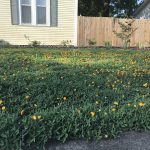
‘Needlepoint’ Perennial Peanut in a yard. Photo Credit: Daniel Leonard, University of Florida/IFAS Extension – Calhoun County
Turfgrass/Groundcover Selection
The University of Florida/IFAS has a long list of publications on alternatives to turfgrass. The comprehensive list can be found at Ask IFAS: Groundcovers.
One of the groundcovers that does well in full sun and has beautiful yellow flowers is perennial peanut. More information on perennial peanut can be found in the publication “Guide to Using Rhizomal Perennial Peanut in the Urban Landscape”.
Groundcover options for the shade include Algerian ivy, Asiatic jasmine, and mondo grass. Read more about these and other shade friendly species at “Gardening Solutions: Groundcovers for the Shade”.
Frogfruit can tolerate full sun and partial shade.
You could also create a wildflower meadow in a sunny spot. More wildflower information is available at Ask IFAS: Performance of Native Florida Plants Under North Florida Conditions.
White clover is a groundcover that may be best suited in a mix with other groundcover species. The publication “White Clover” provides some excellent information on growing this plant.
A number of factors come into play when you are choosing a turfgrass species. Some species are more tolerant of shade than others and maintenance levels are species and variety specific. The “Choosing Grass for Your Lawn” webpages can help answer some common questions. For additional information on turfgrass species a list of EDIS publications and other UF/IFAS websites is available at Ask IFAS: Your Florida Lawn. (Note: Buffalograss is not recommended for Florida.)
Overseeding is not a recommended practice for home lawns, but information is available at the webpage “Overseed Florida Lawns for Winter Color”.
Management of Turf and Groundcovers
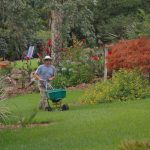
Fertilizing a lawn. Photo Credit: University of Florida
Turfgrass requires the right amount of care. To help maintain a good looking yard, follow the management practices in the publication “Homeowner Best Management Practices for the Home Lawn”.
A soil sample is a good place to start to determine the root of the issues you may have in your lawn. Follow these simple steps to collect and submit a sample for accurate analysis.
Weed management can be difficult in turf and other groundcovers. Cultural, mechanical, and chemical controls can help keep weeds under control. The “Weed Management Guide for Florida Lawns” provides control options for the majority of weeds you’ll encounter in your lawn. More information on weed control in turf alternatives can be found in the publication “Improving Weed Control in Landscape Beds”.
Virginia buttonweed is a common weed that is often difficult to control. Doveweed can also be difficult to control.
The publication “Adopting a Florida Friendly Landscape” outlines the nine principals to help you design, install, and maintain a landscape that will thrive in our climate.
Fertilizer is required to maintain a healthy lawn. A list of lawn fertilization publications and links can be found at Ask IFAS: Lawn Fertilizer.
Lawns in the southeast are susceptible to a number of different diseases mostly thanks to our hot and humid weather. But there are some preventative and curative practices you can implement to help keep disease under control. The “Turfgrass Disease Management” publication answers a lot of questions about disease control.
Past episodes of Gardening in the Panhandle LIVE can be found on our YouTube playlist.
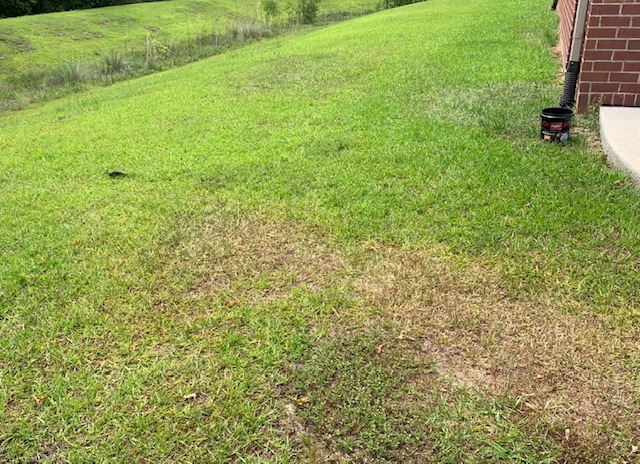
by Larry Williams | Jun 10, 2021
Every time we have a dry period in spring or summer, I get those predictable calls about some mysterious pest that’s playing havoc in lawns.
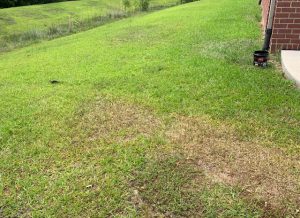
Dry spots in lawn. Photo credit: Larry Williams
Without realizing it, the caller usually describes a textbook example of dry spots in a lawn. And many times that’s what the problem areas are – dry spots.
Dry spots are the result of imperfections in an irrigation system. They are revealed during dry weather. Adequate rainfall masks the imperfections in an irrigation system.
Possible imperfections are many. The homeowner may easily fix some irrigation system problems while other problems may require the expertise of a licensed irrigation contractor. There may be too few sprinkler heads for adequate coverage, insufficient pressure to operate each zone, incorrect choice of nozzles or wrongly mixing rotors with spray heads on the same zone. The cause for dry spots may be as simple as a maladjusted spray head, a broken spray head, a plugged nozzle, a tree or shrub blocking the water, grass that has grown over a pop-up spray head, etc.
Regardless of the cause, there are a couple of simple tests that can help confirm that the problem areas are to be blamed on lack of sufficient water vs. a mysterious pest.
First, check the affected areas by taking a soil sample in the root zone. Use a soil probe or shovel to remove a core of soil to a depth of 6 to 8 inches. Visually inspect and feel the soil sample for moisture. Do the same test in an area of the lawn that looks normal and compare the difference. It should be obvious if there is a difference in moisture between the areas tested.
The second test involves placing several empty straight-sided cans such as tuna fish cans in the affected area and several in a “normal” area of the lawn. Then let the irrigation system run long enough to collect some water in the cans. Compare the amount of water collected in the two areas. It should be obvious if there is a difference in the amount of water applied in the areas tested.
These tests are cheaper, less trouble and more environmentally friendly as compared to purchasing and applying pesticides for nonexistent pests as a result of incorrectly diagnosing the problem. If these tests do not identify the problem as lack of water, you may have a lawn pest. But don’t guess.
Occasionally inspect your irrigation system while it’s running for obvious, easily corrected problems such as a maladjusted or broken spray head. The following UF/IFAS Extension publications will help with your inspection. https://edis.ifas.ufl.edu/entity/topic/residential_sprinkler_systems
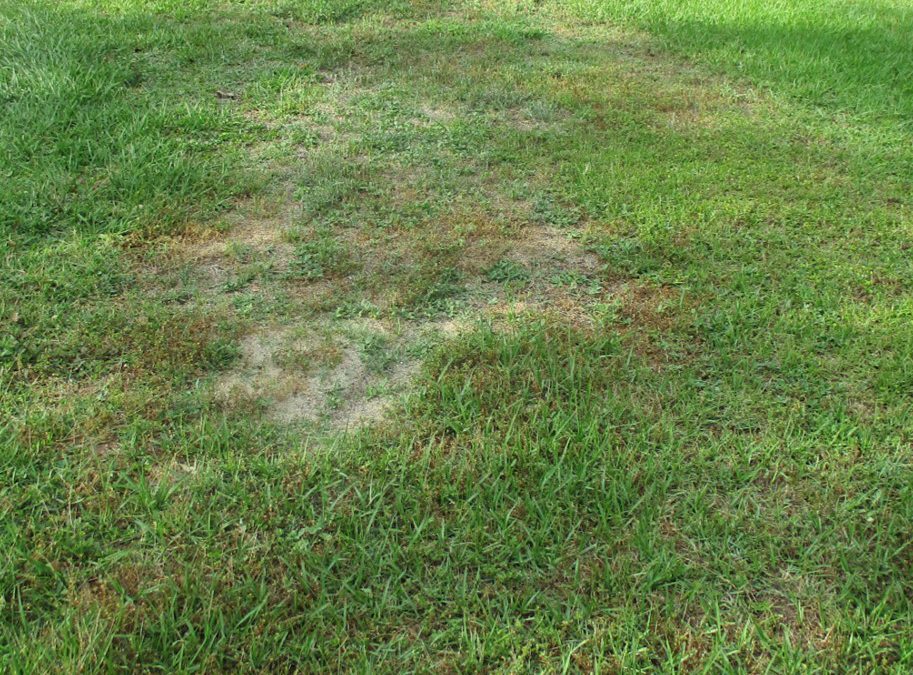
by Larry Williams | Apr 29, 2021
I’ll be the first to admit that North Florida lawns are frustrating. With time, most people discover this.
Why are lawns so difficult here? The answer involves a combination of factors.
We are not far enough north to benefit from the better soils. Florida is known for sandy, low fertility, low water holding capacity soils. Some areas of the country enjoy richer soils with better water and nutrient holding capacities. These better soils result in a more favorable lawn root environment with roots being more competitive and resilient.
Something else happens in more northern areas. The heavier soils and colder temperatures (sometimes resulting in the soil freezing) are natural means of inhibiting and/or controlling certain soil dwelling pests. For example, nematodes are not nearly the concern in northern lawns. Many people that move to our area have never heard of these microscopic roundworms that play havoc in our low fertility, warm, sandy soils. After a lawn has been in place for a number of years, allowing the nematode population to reach a threshold, the lawn begins to decline. And we have few legal, effective chemical control options for nematodes in Florida lawns.
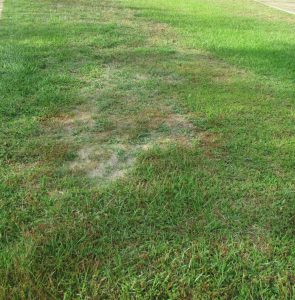
Declining area in lawn due to ground pearl. Photo credit: Larry Williams
Some other soil dwelling pests that northerners don’t have to deal with include ground pearls, small scale-like insects that bother centipedegrass roots. Mole crickets are not a pest much north of Central Alabama. Years ago, a representative with the company that manufactured the once popular mole cricket insecticide Oftanol told me that in the absence of the state of Florida, they would not sell enough Oftanol to keep it on the market. Take-all Root Rot, a common soil dwelling fungus, plays havoc in our Florida lawns and it is difficult to control.
We are not far enough north to use the more trouble-free northern grasses to create a permanent lawn. These include bluegrasses, fescues and perennial ryegrass. At best, these grasses can be used to overseed our lawns during the cooler fall and winter months to create a temporary winter lawn. But they will not survive our hot, wet summers.
We are not far enough south to benefit from the lack of freezing temperatures during winter. A late freeze that occurred on April 8 a number of years ago resulted in much lawn injury. I saw lawns with seventy percent kill from this late freeze. This is something that typically does not happen in Central and South Florida.
We deal with saltwater issues, high humidity, hurricanes and tropical storms, an array of lawn insects and diseases and extremes in rainfall and temperatures.
It’s no wonder most people become dissatisfied with their lawns. Perhaps we should lower our expectations and enjoy the natural flora and fauna of our state.
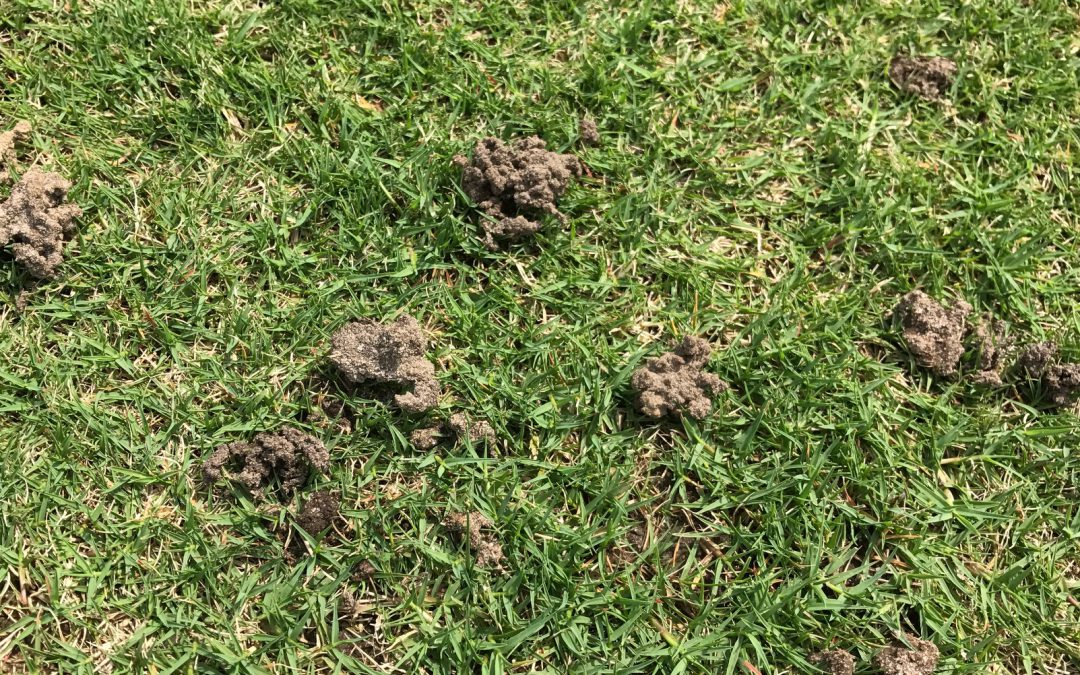
by Mary Salinas | Apr 15, 2021
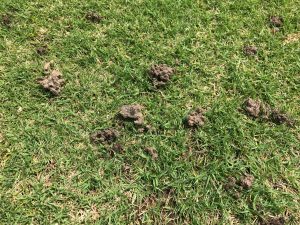
Worm mounds in bermudagrass. Photo credit Mary Salinas, UF IFAS Extension.
The April 8 program of Gardening in the Panhandle LIVE! was focused on turfgrass, quite a popular topic in the springtime as the weather warms and turf comes out of winter dormancy. Here are some of the questions asked of our University of Florida experts and the links to resources they shared.
To start with, two sites that have comprehensive information are Your Florida Lawn: http://hort.ufl.edu/yourfloridalawn/ and Gardening Solutions: https://gardeningsolutions.ifas.ufl.edu/
Turfgrass Selection
Q. What’s the answer to “I want a lawn like I had up north”? Remotely possible?
A. You can have a nice lawn, but it is going to be different in the panhandle. Don’t expect the same grass species or maintenance.
Q. What grass species is recommended for winter overseeding, and when should the grass be sown?
A. Overseeding has its problems and generally not recommended as it shades out the warm season turf as it is coming out of dormancy in the spring. Overseeding Florida Lawns for Winter Color: https://sfyl.ifas.ufl.edu/archive/hot_topics/lawn_and_garden/overseeding_winter_lawns.shtml
Q. How well do new turfgrass varieties thrive against weeds?
A. A healthy and properly maintained lawn is your best defense against weeds and other pests. Additionally, ProVista is a new cultivar of St Augustinegrass that can tolerate glyphosate so it makes it much easier to kill weeds in the lawn. ProVista is not yet widely available in the panhandle.
Q. How do I get a lawn started?
A. Preparing to Plant a Florida Lawn: https://edis.ifas.ufl.edu/lh012
Establishing a Florida Lawn: https://edis.ifas.ufl.edu/topic_lawn_establishment
Q. Can I have a native lawn? What are some recommended alternatives to a turf lawn?
A. Opinions are divided as to whether St. Augustinegrass is native. See these links for lawn Alternatives: https://gardeningsolutions.ifas.ufl.edu/lawns/turf-types/alternatives-to-turfgrass.html
https://gardeningsolutions.ifas.ufl.edu/mastergardener/webinars/mg-update-june2018/ffl-lawn-alternative-mg-update-june-2018-handout.pdf
Fertilizing & Weed Control
Q. How long should I wait before fertilizing new sod?
A. Wait 30-60 days before applying fertilizer. See: Homeowner Best Management Practices for the Home Lawn: https://edis.ifas.ufl.edu/ep236
Q. Basic fertilizer for most lawns if no other information is available.
A. 15-0-15
Q. Are weed and feed products effective? Can you use a Weed & Feed like Scott’s Bonus S this late in the year?
A. Weed and feed products are not recommended.
Weed & Feed, Not Foolproof: https://ocmga.wordpress.com/2013/03/11/weed-and-feed-not-foolproof-by-larry-williams-ufifas-extension-agent/
Weed Management Guide for Florida Lawns: https://edis.ifas.ufl.edu/ep141
Lawn Maintenance & Renovation
Q. My husband overwaters the lawn. Remind everyone about correct watering.
A. Homeowner Best Management Practices for the Home Lawn: https://edis.ifas.ufl.edu/ep236
Watering Your Florida Lawn: https://edis.ifas.ufl.edu/lh025
Sprinkler calibration: https://gardeningsolutions.ifas.ufl.edu/care/irrigation/calibrating-your-irrigation-system.html
Q. What to do about bare spots in St Augustine turf in shade?
A. Rough up the ground and put ½ to 1” compost and let the grass fill in or plant plugs. St. Augustinegrass for Florida Lawns: https://edis.ifas.ufl.edu/lh010
Q. When is the best time to overseed? I have a centipede lawn that’s 15-16 years old and I’m trying to bring it back to health.
A. Be sure to be following good practices and centipedegrass should not fail. Overseeding may not be the best option. Centipedegrass for Florida Lawns: https://edis.ifas.ufl.edu/lh009
Q. How do I repair lawn areas ruined by piled up Hurricane Sally debris?
A. Homeowner Best Management Practices for the Home Lawn: https://edis.ifas.ufl.edu/ep236
Q. How do I care for a zoysiagrass lawn?
A. Zoysiagrass for Florida Lawns: https://edis.ifas.ufl.edu/lh011
Q. Should I mulch or bag clippings?
A. Unless you have disease or weed seeds, mulch the clippings onto the turf so you can return the nutrients and water into the soil. Mowing Your Florida Lawn: https://gardeningsolutions.ifas.ufl.edu/lawns/lawn-care/mowing-your-florida-lawn.html
Pest Management
Q. When is the best time to put out a pre-emergence treatment to control and prevent weeds in your lawn (warm and cool season)?
A. Summer Annual Weed Control Timeline: https://sfyl.ifas.ufl.edu/media/sfylifasufledu/escambia/horticulture/Summer-Annual-Lawn-Weed-Control-Timeline.pdf
Winter Annual Weed Control Timeline: https://sfyl.ifas.ufl.edu/media/sfylifasufledu/escambia/horticulture/Winter-Annual-Lawn-Weed-Control-Timeline.pdf
Q. How do I manage chamberbitter in lawns?
A. Chamberbitter: https://hgic.clemson.edu/factsheet/chamberbitter/
Gallery, with the active ingredient isoxoben, has always been the best product to control chamberbitter. Another product, Gemini, adds prodiamine with isoxoben and also provides good control.
Q. How do you get dollar weed under control?
A. Control irrigation. Dollarweed loves lots of water so make sure you are not overwatering. See: https://edis.ifas.ufl.edu/ep389
Q. I used Image to help control Bahia in Centipede. Anything else that we can use?
A. Metsulfuron methyl, 3 applications every 21 days
Q. Which postemergence herbicide is safe and effective for reducing oxalis in a lawn?
A. Yellow Woodsorrel (Oxalis) Biology and Management in Turf: https://edis.ifas.ufl.edu/ep385
Q. What is the best non-poison weed killer?
A. If a product is a weed killer, whether it is organic or synthetic, it is a poison. Alternatives to Synthetic Herbicides for Container Plants & Homeowner Herbicide Guide: https://edis.ifas.ufl.edu/ep464 & https://edis.ifas.ufl.edu/ep575
Q. How do I treat lawn fungus?
A. First you need to determine which fungus, if any, is responsible. Key to Identification of Landscape Turfgrass Disease: https://edis.ifas.ufl.edu/lh064
Then turn your attention to Turfgrass Disease Management: https://edis.ifas.ufl.edu/lh040
Q. How do I diagnose and control mole crickets?
A. Look at this UF guide: https://edis.ifas.ufl.edu/in1021
This video shows how to do the soap flush to scout for mole crickets https://www.youtube.com/watch?v=sx_o4EMXsCo












